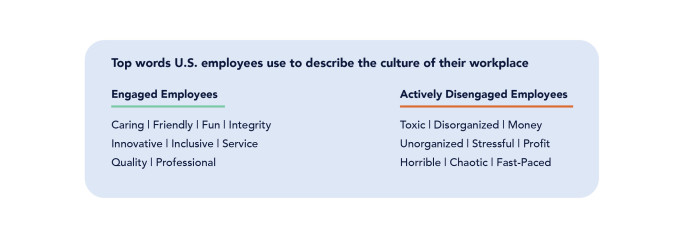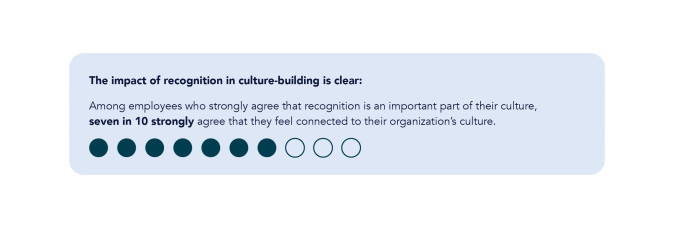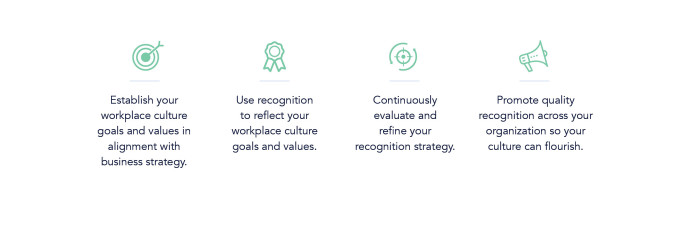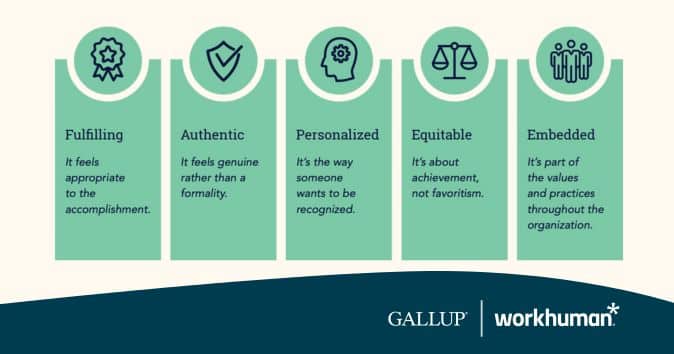Culture of Recognition: What Is It and How Can You Create It?

If you think a good workplace culture is “fluffy” or “nice to have,” think again.
Data from 2023 research on workplace trends paints a startling picture: On the heels of the Great Resignation and the quiet quitting phenomena from recent years, employees are feeling underpaid, undervalued, and prepared to quit their jobs to find better experiences elsewhere.
In fact, more than a third – 37% – of the 4,100 employees surveyed in Workhuman’s Evolution of Work report say they’re looking for a new job, an increase of 1.7x in two years.
If you want to keep your top talent and foster engagement across the organization, it starts by investing in your people.
So, where’s the best place to begin? The answer is much easier than you may think: Recognize your employees for who they are and what they do.
New research from Gallup and Workhuman shows a culture of recognition goes a long way in the workplace. It’s what leads to thriving employees – and, by extension, thriving businesses. The bottom line is this: When companies understand and activate the power of recognition, they cultivate strong cultures that unite their employees and drive them to achieve the organization’s mission.
Let’s explore the new research to better understand what, exactly, a culture of recognition is and how to build it.
What is a culture of recognition?
Before understanding the impact of a culture of recognition, it’s important to first consider exactly why workplace culture matters.
As outlined in Gallup and Workhuman’s new research report, Empowering Workplace Culture Through Recognition, the world of work has shifted. In this new playing field, leaders need to forge and leverage a culture that attracts talented employees to their organization and engages them in driving it forward. However, most organizations are failing to do so – Gallup data shows just two in 10 U.S. employees strongly agree they are connected to their organization’s culture.
Gallup conceptualizes workplace culture simply as “how we do things around here.” More specifically, it’s a function of how people within the organization interact with one another and how they get their work done – and it typically involves rallying people around the organization’s purpose and values.
In a recent Workforce survey, employed members of the Gallup Panel were asked to describe their work culture in three short words or phrases (below). Engaged employees used words such as “caring,” innovative,” and “inclusive,” whereas actively disengaged employees used words such as “toxic,” “disorganized,” and “chaotic.”

The point being that the way people feel about their organization’s day-to-day culture matters. When a workplace culture is broken, people feel it. They talk about it, too.
When leaders practice recognition and emphasize its importance, it sparks a chain reaction. Leaders signal to employees, and soon employees signal to one another, what’s important to them by expressing recognition, gratitude, and appreciation for the things they want to see more of in their organization.

Add to the equation that recognition can be targeted to promote the desired cultural elements of any organization. It can also be adjusted and fine-tuned over time to adapt to changing workplace demands.
In that sense, a culture of recognition is a consistent way for leaders to communicate their cultural goals and expectations. It’s essential in helping employees develop a robust connection to their workplace culture. It also helps create unity not just in stated values, but in the way work gets done across an organization.
Examples of recognition culture
Recognition is one of the strongest forces for building and maintaining culture and engaging employees – but it looks different for every organization. Let’s look at some of the best examples of recognition culture:
GoTo
Since launching its recognition platform in 2017, GoTo has learned a thing or two about navigating cultural change. With a predominantly remote staff and a corporate rebrand from LogMeIn to GoTo, the organization continues to use its recognition platform to boost transparency, increase engagement, and promote its values.
What it all boils down to is this: GoTo is using recognition to level up its culture. And it shows: Since its launch, GoTo has seen a 95% engagement with its recognition program.
“We really believe in living our values,” says Christine Grant, Staff Compensation Analyst at GoTo. “Our employees know what our values and our goals are in the macroeconomic sense, but, in the microeconomic, real-world examples, they see that through recognition. It’s what ties all the different silos of our business together.”
Hear more about how GoTo is infusing recognition into company culture:
R1
R1, the leading provider of technology-driven solutions to transform the patient experience and financial performance of healthcare providers, is a global organization with 28,000+ employees located in the U.S., India, and the Philippines. For R1, recognition helps foster a culture of connection across geographies – and Workhuman integrations with Microsoft Teams and Workday enable seamless recognition in the flow of work.
Since launch, R1 has achieved a 98% recipient reach for recognition. In doing so, R1 has established a strong culture of recognition that has resulted in improved employee engagement.
“When we started our journey with recognition, this came from employee feedback,” says Culture Programs Manager Sara LaBelle. “In our engagement survey, we heard from employees that they wanted more recognition! We continue to invest in more ways that ensure our associates feel recognized to therefore help drive that employee engagement.”
Hear more about how R1 is fostering a culture of connection with recognition:
Zimmer Biomet
Zimmer Biomet, a global medical technology leader, launched its recognition platform in 2021, with two primary goals: 1) Building a strong culture that reinforces company values, and 2) Uniting multiple, disparate recognition systems under one program that delivers measurable results.
Since its launch, Zimmer Biomet has increased its recognition reach from 43% to over 70%, nearly doubling the percentage of people who are giving recognition, as well as the frequency of recognition. But the bigger impact is that team members are feeling more connected to one another and to the organization’s mission: to alleviate pain and improve the lives of people around the world.
In fact, Zimmer Biomet reevaluated one of its strategic pillars – to be a best and preferred place to work – as a result of its recognition program, ensuring every employee felt they were bringing value to the organization.
“When I think about how it makes me feel when someone recognizes me, it’s that value,” says Andrea LaBarbera, VP of Global Talent & Engagement at Zimmer Biomet. “That is the motivator. That is what gets you out of bed every day and gets you excited about what you do. Because you not only see the impact it has on other people’s lives but also the value you feel you are bringing to the organization is getting recognized.”
Hear more about how Zimmer Biomet made recognition a critical strategic pillar for the organization:
How to build a culture of recognition in the workplace
Even the best examples of successful organizations building strong cultures of recognition can leave you wondering: How can I get started?
As outlined in Gallup and Workhuman’s new research report, there are four practical steps for transforming your culture through recognition.

Let’s explore each in more detail:
Establish your workplace culture goals and values in alignment with business strategy
The first step in transforming your culture should always be to define the culture you’re striving toward. While your organization’s mission statement and long-term goals may help to describe what your organization does and why, your culture determines how it’s done.
But establishing your workplace culture goals extends beyond identifying overarching values to adhere to – you also need to define the daily behaviors, rituals, and routines that will best support your business strategy.
Ask yourself these questions: How do employees stay in touch and communicate throughout the day? How are decisions made? How are anniversaries at work celebrated? How close are employees across departments and levels of leadership? And perhaps today’s most pressing question: Where do employees work?
Use recognition to reflect your workplace culture goals and values
Once you’ve established the culture that you want to create, you need to clearly communicate it throughout the organization and generate buy-in. Recognition bridges the goals for your culture from being ideals to becoming tangible behaviors.
Recognition models and positively reinforces how your ideal culture will manifest in employees’ day-to-day lives. Simply stating a value but doing nothing to reinforce it can lead to feelings of ambiguity or disinterest among employees.
Instead, when you recognize employees for behaviors that exemplify the culture your organization aspires to, they gain insight into what is expected of them and are more likely to engage in similar behaviors in the future.
Continuously evaluate and refine your recognition strategy
As you lean into using recognition as a tool to transform your organization’s culture, it’s critical you make proactive, intentional assessments of the story being told by the recognition being given across your organization. Even if you’ve done all the foundational work, the direction of your recognition program can sometimes drift off target.
Through analytical insights and conversations with employees across the organization, evaluate not only if you are still promoting the workplace culture you’ve set out to achieve, but also consider how it’s coming to life.
Recognition programs provide invaluable real-time data about how your organization’s culture is manifesting. A thorough comparative analysis can reveal any inequities or biases present in how recognition is being given and map out where your culture is catching on. These data can also be leveraged to understand what is and is not being recognized and inform any needed adjustments.
For example, if you value a high-performance culture of activation and execution, are employees only being recognized for putting out fires to ensure delivery at the last minute, or are they also praised for the initial efficiency, thoughtfulness, and energy invested into their work being done right? Both behaviors can be fairly classified as “high performance,” but each may correspond with different dimensions of the workplace culture you seek to achieve.
Promote quality recognition across your organization so your culture can flourish
While cultural transformation may start with the leaders, it’s not complete until it takes hold throughout your organization. The final, ongoing step to help you achieve your cultural goals is to practice and promote the delivery of recognition in the most effective ways across all levels of your organization.
As noted in prior Gallup and Workhuman research, there are five essential pillars to strategic recognition. These serve as a blueprint for promoting quality recognition, and maximizing the speed and strength by which your culture develops.

To accelerate and sustain their cultural transformation, leaders should familiarize themselves with and hone their skills in applying the five pillars of strategic recognition. To amplify these effects, leaders can educate employees across all levels of the organization on best practices for giving recognition.
The full power of recognition is unlocked when an organization finds ways to embed it as part of its culture and incorporate it into a daily practice.
Final thoughts
Now that you've developed a broad understanding of what a culture of recognition is, why it’s important, and how to build (and sustain) it across your organization, the question becomes: What will you start doing, today, to infuse gratitude into your workplace?
Download our exclusive report to discover 4 practical steps for unlocking the power of recognition and transforming your workplace culture.
About the author
Stacy Thompson
Stacy Thompson is senior director of content strategy & activation at Workhuman. A lover of language, Stacy focuses on bringing company stories to life from ideation to execution. A Midwestern native, Stacy lives in Billerica, MA with her husband, two kids, and two cats – and spends her time outside of work running, skiing, writing, reading, and yoga-ing.